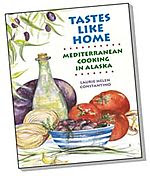After returning from language school in Taormina, Sicily, my sister continued to crave Sicilian food. She discovered a recipe for Sicilian Pasta with Sardines on Epicurious that was so good she ate the leftovers for breakfast and lunch the next day. Pasta with Sardines and Fennel is a simple recipe, made primarily with pantry staples. I will happily make it over and over again.
Pasta with Sardines is one of Sicily’s classic dishes, and there are countless recipes for it. In The Flavors of Sicily, Anna Tasca Lanza refers to it as “the national dish of Sicily.” Lanza, the owner of Sicily’s Regaleali winery and Sicilian food expert, says Pasta with Sardines and Fennel contains all the classic elements of Sicilian food: “fennel from the earth, fish from the sea, pine nuts from the trees, dried currents from the vine, … and that most Sicilian of ingredients, pasta.”
Some versions of the dish contain saffron, some use tomato sauce, and others augment the sardines with anchovies. The two constants are sardines and fennel.
This is my adaptation of Pasta with Sardines and Fennel, using the Epicurious recipe as a starting point, but modifying it significantly to enhance the primary elements of sardines and fennel. The flavors of the finished dish are so balanced that no single ingredient stands out; had I not made it myself, I wouldn’t have known it contained sardines. It’s a gloriously harmonious creation. Pasta with Sardines and Fennel
Pasta with Sardines and Fennel
Serves 4
1/2 cups currants
3/4 cup white wine
1/2 cup pine nuts
2 Tbsp. olive oil
1/3 cup Panko (dried breadcrumbs)
2 cans sardines in olive oil
2 large or 4 small fennel bulbs (3 1/2 cups diced)
4 cups diced yellow onions, 1/4” dice
1/2 cup olive oil
2 Tbsp. fennel seeds, crushed
1 tsp. crushed red pepper flakes
Salt
Freshly ground black pepper
1 Tbsp. minced garlic
1 lb. penne, or any other pasta
Mix the currents and wine in a small bowl. Set aside.
Toast the pine nuts in a dry frying pan over medium heat, watching carefully to make sure they don’t burn. Put the pine nuts in a bowl large enough to hold the cooked pasta.
Add 2 Tbsp. olive oil to the frying pan, and brown the Panko in the oil, stirring frequently, until the breadcrumbs are lightly toasted. Set aside.
Open the sardines, drain off the oil, put the sardines in a small bowl, and mash them with a fork. Add half the mashed sardines to the bowl with the toasted pine nuts, and set aside the remaining half of the sardines.
Cut the stalks off the fennel bulb, cut the bulb in half, remove the hard core, and dice the fennel bulb into 1/4” dice. Remove the green fronds from the fennel stalks, chop them, and add to the bowl with the pine nuts. Discard the fennel stalks.
Sauté the onions, fennel bulb, fennel seeds, red pepper flakes, salt, and freshly ground black pepper in 1/4 cup olive oil until the fennel is tender, about 15 minutes. Stir in the wine, currents, reserved mashed sardines, and the remaining 1/4 cup olive oil, and simmer for 1-2 minutes. Taste and add salt and freshly ground black pepper, as needed.
While cooking the onions and fennel, boil the pasta in salted water until it is al dente. Drain the pasta and add it and the hot fennel-onion mixture to the bowl with the pine nuts. Toss well. Add the toasted bread crumbs and toss again. Serve with a crisp green salad and black olives.
Saturday, November 3, 2007
Recipe: Pasta with Sardines and Fennel
Subscribe to:
Post Comments (Atom)




2 comments:
ha. that is so funny that you said watch the pine nuts. I burned both the nuts AND the bread crumbs. p.s. why do the pine nuts these days come from china?
In my life I have probably burnt as many pine nuts as I've eaten. It's sad. That's why I like the big Costco bags -- you have plenty to try again after the first batch goes in the garbage.
The year we were in Greece, we lived across the street from a stand of pine trees and thought we were really clever to collect the cones with the idea of getting free pine nuts. Something for nothing. What a joke. The shell around the pine nut is so hard that when we cracked them, the meat inside was destroyed. It made me understand why they are so expensive - they are a royal pain to clean.
I know the pine nuts from China are from a different species. Maybe the ones there don't have such hard shells? Or maybe it's just a function of cheap labor?
Post a Comment